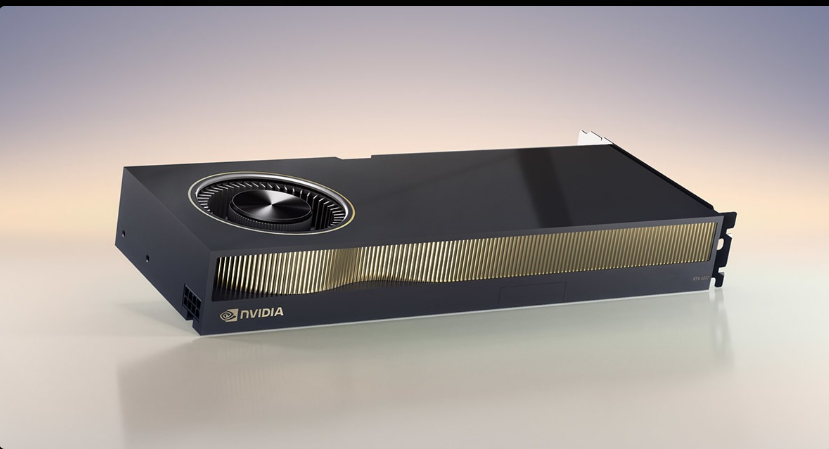
In the world of GPUs, the NVIDIA RTX A6000 stands out as a powerhouse designed to tackle the most demanding workloads. Whether you’re working on machine learning (ML), deep learning, or professional video rendering, the RTX A6000 delivers unparalleled performance, making it the go-to choice for professionals and researchers alike.
The NVIDIA RTX A6000 is a high-performance GPU designed for professionals in fields such as machine learning, deep learning, and video rendering. Built on the advanced NVIDIA Ampere architecture, it features 10,752 CUDA cores, 336 Tensor cores, and 84 RT cores, enabling exceptional performance for compute-intensive tasks. With 48 GB of GDDR6 memory, the A6000 can handle large datasets and complex models efficiently, making it ideal for applications in scientific research, content creation, and architectural visualization. Its capabilities in real-time ray tracing and AI acceleration allow for photorealistic rendering and rapid model training, significantly enhancing productivity in demanding workflows. The RTX A6000 is certified by numerous independent software vendors, ensuring compatibility and reliability across a wide range of professional applications.
The NVIDIA RTX A6000 excels in high-performance computing with its 38.71 TFLOPS FP32 performance, significantly enhancing workflows in fields like CAD and CAE. Its third-generation Tensor Cores enable rapid AI model training without code changes, while broad application certification ensures reliability across various industries, making it a versatile professional tool.
key specifications of the NVIDIA RTX A6000:
| Specification | Details |
|---|---|
| CUDA Cores | 10,752 |
| Tensor Cores | 336 (third-generation) |
| RT Cores | 84 (second-generation) |
| GPU Memory | 48 GB GDDR6 with ECC |
| Memory Interface | 384-bit |
| Memory Bandwidth | 768 GB/s |
| Single-Precision Performance | 38.7 TFLOPS |
| Tensor Performance | 309.7 TFLOPS |
| RT Core Performance | 75.6 TFLOPS |
| Power Consumption | 300 W |
These specifications underscore the A6000’s capability to handle complex workloads, making it particularly well-suited for tasks that require high levels of parallel processing, such as ML model training and high-quality video rendering.
Why the RTX A6000 is Perfect for Machine Learning
1. Massive Memory for Large Models
Machine learning tasks often require handling extensive datasets and training complex models. The RTX A6000’s 48GB memory ensures that even the most demanding models can be trained efficiently without memory bottlenecks. This is especially useful for applications like natural language processing (NLP) and computer vision.
2. Incredible Tensor Core Performance
The A6000’s Tensor cores accelerate matrix operations essential for deep learning frameworks like TensorFlow and PyTorch. This means faster training times and lower operational costs for developers and researchers.
3. Multi-GPU Scalability with NVLink
For large-scale ML projects, you can connect multiple RTX A6000 GPUs using NVLink. This enables seamless data sharing between GPUs and dramatically improves training efficiency for massive datasets.
Video Rendering at its Finest
1. Unmatched Rendering Speeds
With 10,752 CUDA cores and Ampere’s advanced architecture, the RTX A6000 excels in rendering complex 3D models and animations. Software like Blender, Cinema 4D, and Adobe Premiere Pro runs flawlessly, even when handling 8K footage or intricate VFX.
2. Real-Time Ray Tracing
Thanks to 2nd generation RT cores, professionals can render photorealistic images and animations with real-time ray tracing. This significantly reduces rendering times and enhances output quality.
3. 48GB Memory for Heavy Workloads
When working with high-resolution textures, detailed models, and large projects, the A6000’s massive memory ensures smooth performance without crashing or lag.
Deep Learning Applications
1. Accelerating Training and Inference
The RTX A6000’s combination of Tensor cores, CUDA cores, and large memory makes it ideal for training and deploying deep learning models. Tasks like image recognition, language translation, and autonomous driving simulations become faster and more efficient.
2. High-Precision AI
The A6000 supports mixed-precision training, allowing developers to balance speed and accuracy. It’s perfect for researchers working on cutting-edge AI models that require both speed and precision.

RTX A6000 vs. Competitors
When compared to other GPUs in its class, such as the NVIDIA RTX 4090 or A100, the RTX A6000 offers:
- Professional-Grade Stability: Unlike consumer GPUs, the A6000 is designed for enterprise-level reliability.
- Higher Memory Capacity: Its 48GB memory surpasses most GPUs, making it a better choice for ML and rendering tasks.
- Workstation Optimization: Certified drivers ensure compatibility and stability with professional software.
Who Should Invest in the RTX A6000?
The NVIDIA RTX A6000 is perfect for:
- Data Scientists and AI Researchers: For training large ML models and running AI simulations.
- Video Editors and VFX Artists: For handling high-resolution projects and real-time rendering.
- 3D Modelers and Designers: For creating intricate designs and animations without performance bottlenecks.
Conclusion
The NVIDIA RTX A6000 is a beast of a GPU, offering the perfect blend of power, memory, and scalability for professionals in ML, deep learning, and video rendering. Its cutting-edge features and enterprise-grade reliability make it a worthwhile investment for anyone working on demanding computational tasks.
If you’re serious about taking your projects to the next level, the RTX A6000 is the GPU to beat. Its performance, versatility, and unmatched capabilities set a new standard in the world of professional graphics and AI.
Leave a Reply
You must be logged in to post a comment.